AKANTHINA
WYDAWNICTWO AKANTHINA

Nicholas Sekunda, Hellenistic Infantry Reforms of the 160’s BC, Seria Monografyczna ‘Akanthina’ nr 1, Gdańsk 2006, ISBN , B5 (17 x 24 cm), str. 189, fig. 36; 25 €/ 112.50 PLN
W książce wysunięto tezę, że ciężkozbrojna piechota ptolemejska i seleukidzka została ponownie wyposażona i zreorganizowana na rzymską modłę w latach 60-tych II w. 90 p.n.e. Po raz pierwszy militarne sukcesy Rzymu zmusiły świat helleński do zaakceptowania faktu, że hellenistyczna falanga nie sprostała manipularnemu systemowi taktyki rzymskiej i konieczna była zmiana wyposażenia, organizacji i taktyki ciężkozbrojnej piechoty. Dowody na reformę wojskową pochodzą z niezwykle różnorodnych źródeł: literackich, epigraficznych, papirusowych i ikonograficznych.
Ponieważ więcej dowodów jest dla armii ptolemejskiej, temu zagadnieniu poświęcono rozdział I. Najpierw przeanalizowano dowody na pierwotną organizację armii ptolemejskiej, następnie przedstawione zostały dowody epigraficzne i papirusowe, że reforma miała miejsce, gdyż ten typ dowodów dostarcza konkretnych dat dla zmian. Na koniec omówione zostały różne przykłady przedstawień lub prawdopodobnych przedstawień ciężkiej piechoty ptolemejskiej, wyposażonej na sposób rzymski. Dyskusja o dowodach zakończy się omówieniem tzw. tarczy Kasr el Harit, tarczy typu rzymskiego, która prawdopodobnie była używana przez piechotę ptolemejską.
W rozdziale II przedstawiono dowody na reformę ciężkiej piechoty Seleukidów. Dowodów tych jest zdecydowanie mniej niż w przypadku armii ptolemejskiej; są one trudniejsze do zinterpretowania, co jest regułą w niemal wszystkich aspektach funkcjonowania państwa Seleukidów. Mimo to można jednak wykazać, że armia ta została zreorganizowana w latach 60-tych II wieku 160 p.n.e. Podstawowym dowodem, jaki posiadamy, jest literacka wzmianka o 5000 żołnierzach piechoty, uzbrojonych w sposób rzymski; uczestniczyli oni w paradzie w Dafne, w r. 166 p.n.e.
Dalsza dyskusja prowadzona jest w siedmiu aneksach, w których omówiono dowody na wcześniejszy wpływ rzymskiej piechoty na armie hellenistyczne. Dowodami są: Taktyka Posejdoniosa z Rodos, datowanie grobu "Żołnierzy" z Sydonu, data i cel parady w Dafne, wzmianki u Polibiusza na temat Antiocha IV, terakota z Kampyr-Tepe, dalsze świadectwa na temat reform piechoty w armiach późno-hellenistycznych.
Ten tom jest to ponowna edycja książki pierwotnie opublikowanej przez Oficynę Naukową MS, Łódź 2001, a będącego rozprawą habilitacyjną autora.
Nicholas Sekunda, Hellenistic Infantry Reforms of the 160’s BC, Monograph Series ‘Akanthina’ no. 1, Gdańsk 2006, ISBN , B5 (17 x 24 cm), pp. 189, fig. 36; 25 €/ 112.50 PLN.
The thesis advanced in this book is that both the Ptolemaic and Seleucid heavy infantry were re-armed and re-organized along Roman lines during the 160’s BC. This was the first time that the military successes of Rome forced the Hellenistic world to accept the fact that the Hellenistic phalanx was no match to the Roman manipular tactical system, and that it was necessary to change the equipment, or¬ganization and tactics of their heavy infantry. The evidence for military reform comes from an extremely varied range of sources, literary, epigraphic, papyrological and representational.
As the evidence is more conclusive for the Ptolemaic army, this will be dealt with first in Chapter 1. First the evidence for the prior organization of the Ptolemaic army is considered, then the epigraphic and papyrological evidence for reform is discussed first as this type of evidence can give concrete dates for the change. Finally the various individual examples of representations, or possible representations, of Ptole¬maic heavy infantry equipped in the Roman manner will be discussed. The discus¬sion of the Ptolemaic evidence will conclude with a discussion of the Kasr el Harit shield, a shield of Roman type which was probably used by a Ptolemaic infantry¬man.
In Chapter 2 the evidence for reform of the Seleucid heavy infantry is dis¬cussed. The Seleucid evidence is much more sparse and difficult to interpret than the Ptolemaic, which is true of virtually all aspects of the Seleucid state. Neverthe¬less it is possible to demonstrate that the Seleucid heavy infantry too was reformed along Roman lines in the 160s. The principal piece of evidence we pos¬sess is a literary reference to 5,000 infantrymen ‘armed in the Roman manner’ participating in the Daphne Parade in 166 BC.
Further discussion is carried out in seven appendices, which discuss the evidence for previous influence of Roman infantry on Hellenistic armies, the Taktika of Poseidonius of Apemeia, the date of the Sidon ‘Soldiers’ Tomb, the date and purpose of the Daphne Parade, Polybius on Antiochus IV, the Kampyr-Tepe Terracotta, and further evidence for infantry reform in Late Hellenistic armies.
This volume is a re-edition of the same work originally published by Oficyna Naukowa MS, Łodź 2001, which was the habilitation dissertation of the author.
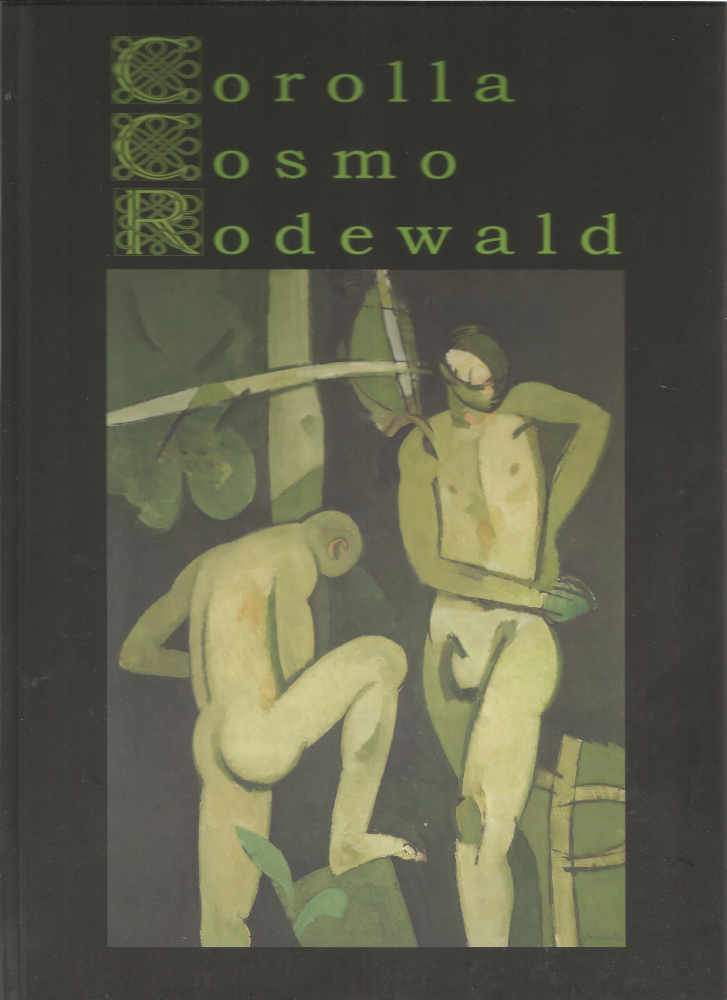
ed. Nicholas Sekunda, Corolla Cosmo Rodewald, Monograph Series ‘Akanthina’ no. 2, Gdansk 2007, ISBN 978-83-7531-060-3, A4 (21 x 29,7 cm), pp. 192, pl. 4; 20,00 € / 90,00 PLN.
There follow contributions by Antony Keen and Nicholas Sekunda (Xenophon the Rhetor), David Whitehead (The Rein and the Spur), Stephen Hodkinson (The Episode of Sphodrias as a source for Spartan social history), †John Graham (Plato’s Anachronisms), John Davies (The Phokian Hiersosylia at Delphi: Quantities and consequence), Simon Nortwood (Q. Fabius Pictor: was he an Annalist?), John Briscoe (Polybius, Livy, and the Disaster of the Macedonian Royal House), Anthony Birley (Sejanus: his fall), Paul Holder (Observations on the Inner faces of some Auxiliary Diplomas from the Reign of Antoninus Pius), Robin Seager (Notes on Ammianus Marcellinus XVIII), Nick Higham (Arthur, Joshua and the Isrealites: History and its purposes in early ninth-century North Wales).
Cosmo Rodewald (zmarły w 2002 roku) był starszym wykładowcą na Wydziale Historii uniwersytetu w Manchesterze. Corolla Cosmo Rodewald to zbiór historycznych rozpraw na temat greckiego i rzymskiego świata, napisanych przez byłych kolegów, uczniów i osoby, które zechciały wyrazić swój podziw dla Cosmo: to rodzaj uczczenia pamięci tego wielkiego człowieka. Redaktorem książki jest Nicholas Sekunda. Pierwsza część pracy poświęcona jest życiu badacza i obejmuje rozdziały napisane przez Alastera Jacksona (Cosmo Rodewald at Manchester University 1947-1976) oraz Victora Sayera i Nicholasa Sekundę (Cosmo Rodewald’s Philanthropy). Następnie zamieszczono teksty: Antony Keena i Nicholasa Sekundy (Xenophon the Rhetor), Davida Whiteheada (The Rein and the Spur), Stephena Hodkinsona (The Episode of Sphodrias as a source for Spartan social history), †Johna Grahama (Plato’s Anachronisms), Johna Daviesa (The Phokian Hiersosylia at Delphi: Quantities and consequence), Simona Nortwooda (Q. Fabius Pictor: was he an Annalist?), Johna Briscoe (Polybius, Livy, and the Disaster of the Macedonian Royal House), Anthony Birley’a (Sejanus: his fall), Paula Holdera (Observations on the Inner faces of some Auxiliary Diplomas from the Reign of Antoninus Pius), Robina Seagera (Notes on Ammianus Marcellinus XVIII), Nicka Highama (Arthur, Joshua and the Isrealites: History and its purposes in early ninth-century North Wales).
ed. Nicholas Sekunda, Corolla Cosmo Rodewald, Monograph Series ‘Akanthina’ no. 2, Gdansk 2007, ISBN 978-83-7531-060-3, A4 (21 x 29,7 cm), pp. 192, pl. 4; 20,00 € / 90,00 PLN.
Cosmo Rodewald, who died in 2002, was Senior Lecturer in the History Department at Manchester University. Corolla Cosmo Rodewald is a collection of historical essays on the Greek and Roman world written by former colleagues, pupils and admirers of Cosmo, and intended as a gesture to honour the memory of a great man. The book has been edited by Nicholas Sekunda. The first part of the book deals with the life of the man, and comprises three chapters written by Alaster Jackson and Nicholas Sekunda (Cosmo Rodewald 1915-2002: A Brief Biogaphy), Alaster Jackson (Cosmo Rodewald at Manchester University 1947-1976), and Victor Sayer and Nicholas Sekunda (Cosmo Rodewald’s Philanthropy). There follow contributions by Antony Keen and Nicholas Sekunda (Xenophon the Rhetor), David Whitehead (The Rein and the Spur), Stephen Hodkinson (The Episode of Sphodrias as a source for Spartan social history), †John Graham (Plato’s Anachronisms), John Davies (The Phokian Hiersosylia at Delphi: Quantities and consequence), Simon Nortwood (Q. Fabius Pictor: was he an Annalist?), John Briscoe (Polybius, Livy, and the Disaster of the Macedonian Royal House), Anthony Birley (Sejanus: his fall), Paul Holder (Observations on the Inner faces of some Auxiliary Diplomas from the Reign of Antoninus Pius), Robin Seager (Notes on Ammianus Marcellinus XVIII), Nick Higham (Arthur, Joshua and the Isrealites: History and its purposes in early ninth-century North Wales).
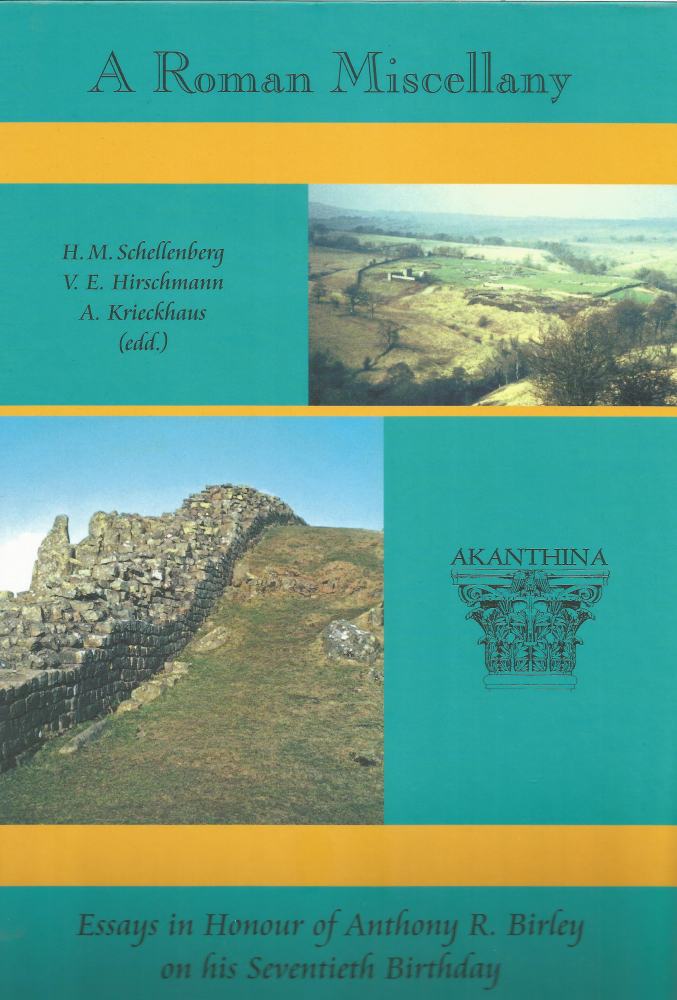
red. H.M. Schellenberg, V.E. Hirschmann, A. Krieckhaus, A Roman Miscellany. Essays in Honour of Anthony R. Birley on his Seventieth Birthday, Seria Monografyczna ‘Akanthina’ nr 3, Gdansk 2008, ISBN 978-83-7531-146-4, A4 (21 x 29,7 cm), str. 236, 51 zdjęć czarno-białych i 3 mapy razem z 10. dodatkowymi na płycie CD-Rom; 20,00 € / 90,00 PLN.
Anthony R. Birley, czołowy autorytet w dziedzinie prozopografii rzymskiej, znany też z biografii cesarzy Hadriana, Marka Aureliusza i Septymiusza Sewera, był profesorem historii starożytnej uniwersytetu w Manchesterze w latach 1974-1990 oraz w uniwersytetu im. Heinricha Heine w Düsseldorfie od 1990 do 2002 roku. Przyjaciele, koledzy i uczniowie zadedykowali mu Roman Miscellany, które zawiera szeroką gamę tematów związanych z Imperium Rzymskim, będącym Festschrift dla wybitnego uczonego. Osiem artykułów napisanych jest w języku angielskim, jeden - fragment powieści historycznej - w języku francuskim, reszta w języku niemieckim. Książka została wydana przez ostatnich trzech uczniów Birley’a w Düsseldorfie.
Po krótkim wstępie Hirschmanna i Krieckhausa (‘Statt eines Vorwortes’) i dodatku samego Birleya, następuje seria artykułów: Bruno Bleckmanna (‘Kritische Passagen zu Konstantin in der Vita Constantini des Eusebios’), Lukasa de Blois (‘Soldiers and Leaders in Plutarch’s Galba and Otho’), Hannah M. Cotton (‘In Lieu of an Article: Reflexions on Hadrian, Antiochus Epiphanes and the Jews’), Wernera Ecka and Andreasa Pangerla (‘Neue Diplome für die Hilfstruppen von Britannia’), Marka Hassalla (‘Footnotes to The Fasti’), Very E. Hirschmann (‘Die phrygische Opposition. Zu Novatianern und Montanisten im westlichen Kleinasien’), Petera Lampe (‘Paulinos Mystes’), Davida Mattingly (‘Urbanism, epigraphy and identity in the towns of Britain under Roman Rule’), Françoisa Paschouda (‘Sulpicii Alexandri ex agente in rebus De uita sua’), Olli Salomies (‘Choosing a Cognomen in Rome. Some Aspects’), Hansa M. Schellenberga (‘Anmerkungen zu Heron von Alexandria und seinem Werk über den Geschützbau’), Stefana Sommera (‘Vereinigungen in Tarsos’), Richarda Talberta (‘A Forgotten Masterpiece of Cartography for Roman Historians: Pierre Lapie’s Orbis Romanus ad Illustranda Itineraria (1845)’), Konrada Vössinga (‘Sallust und das “Massaker von Cirta” 112 v.Chr. (Sall. Iug. 26)’), Klausa Wachtela (‘Fragment einer Bauinschrift aus Sexaginta Prista (Moesia inferior)’), Everetta L. Wheelera (‘Pullarii, Marsi, Haruspices, and Sacerdotes in the Roman Imperial Army’), Davida Whiteheada (‘Apollodorus’ Poliorketika: Author, Date, Dedicatee’), Ruprechta Zieglera (‘Zur Münzemission in Anemurion (Kilikien) unter Kaiser Maximinus Thrax’), Hansa M. Schellenberga (‘Danksagungen mit einer Anmerkung zum Vorhandensein der Vielzahl persönlicher Fotografien’), i bibliografia Birleya z lat 1961-2007. Dodatkowy CD-Rom, dodany do książkim zawiera mapy ilustrujące artykuł Talberta.
edd. H.M. Schellenberg, V.E. Hirschmann, A. Krieckhaus, A Roman Miscellany. Essays in Honour of Anthony R. Birley on his Seventieth Birthday, Monograph Series ‘Akanthina’ no. 3, Gdansk 2008, ISBN 978-83-7531-146-4, A4 (21 x 29,7 cm), pp. 236, b/w pictures 51 and 3 maps with additional 10 maps on a CD-Rom; 20,00 € / 90,00 PLN.
Anthony R. Birley, a leading authority in the field of Roman prosopography and well known for his biographies of the emperors Hadrian, Marcus Aurelius and Septimius Severus, was Professor of Ancient History at the University of Manchester from 1974-1990 and at the Heinrich Heine University, Düsseldorf from 1990 until retirement in 2002. Friends, colleagues and pupils have offered him A Roman Miscellany, on a rich variety of topics relating to the Roman Empire, a Festschrift for an outstanding scholar. Eight contributions are in English, one—an excerpt from a historical novel—is in French, the rest are in German. The book is edited by Birley’s last three Düsseldorf pupils.
After a short introduction, by Hirschmann and Krieckhaus (‘Statt eines Vorwortes’), and a ‘Postscript’ by Birley himself, there follow the contributions by Bruno Bleckmann (‘Kritische Passagen zu Konstantin in der Vita Constantini des Eusebios’), Lukas de Blois (‘Soldiers and Leaders in Plutarch’s Galba and Otho’), Hannah M. Cotton (‘In Lieu of an Article: Reflexions on Hadrian, Antiochus Epiphanes and the Jews’), Werner Eck and Andreas Pangerl (‘Neue Diplome für die Hilfstruppen von Britannia’), Mark Hassall (‘Footnotes to The Fasti’), Vera E. Hirschmann (‘Die phrygische Opposition. Zu Novatianern und Montanisten im westlichen Kleinasien’), Peter Lampe (‘Paulinos Mystes’), David Mattingly (‘Urbanism, epigraphy and identity in the towns of Britain under Roman Rule’), François Paschoud (‘Sulpicii Alexandri ex agente in rebus De uita sua’), Olli Salomies (‘Choosing a Cognomen in Rome. Some Aspects’), Hans M. Schellenberg (‘Anmerkungen zu Heron von Alexandria und seinem Werk über den Geschützbau’), Stefan Sommer (‘Vereinigungen in Tarsos’), Richard Talbert (‘A Forgotten Masterpiece of Cartography for Roman Historians: Pierre Lapie’s Orbis Romanus ad Illustranda Itineraria (1845)’), Konrad Vössing (‘Sallust und das “Massaker von Cirta” 112 v.Chr. (Sall. Iug. 26)’), Klaus Wachtel (‘Fragment einer Bauinschrift aus Sexaginta Prista (Moesia inferior)’), Everett L. Wheeler (‘Pullarii, Marsi, Haruspices, and Sacerdotes in the Roman Imperial Army’), David Whitehead (‘Apollodorus’ Poliorketika: Author, Date, Dedicatee’), Ruprecht Ziegler (‘Zur Münzemission in Anemurion (Kilikien) unter Kaiser Maximinus Thrax’), Hans M. Schellenberg (‘Danksagungen mit einer Anmerkung zum Vorhandensein der Vielzahl persönlicher Fotografien’), and Birley’s ‘Bibliography from 1961 to 2007’. The CD-Rom included with the book contains the huge maps illustrating Talbert’s paper.
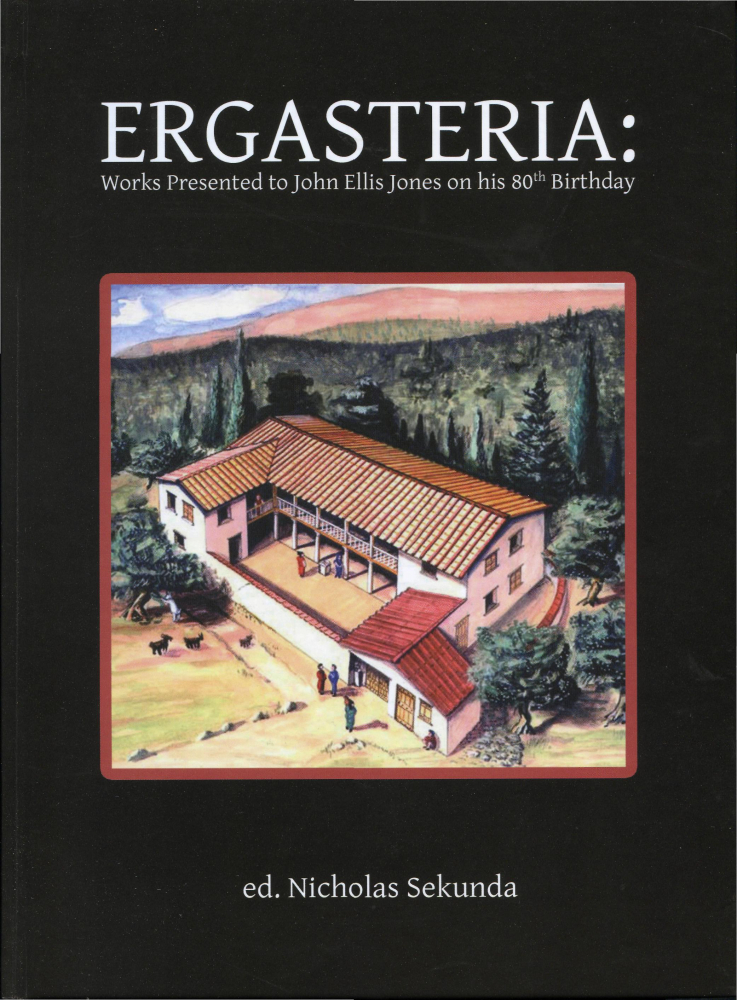
red. Nicholas Sekunda. ERGASTERIA: Works Presented to John Ellis Jones on his 80th Birthday, Seria Monografyczna ‘Akanthina’ nr 4, Gdańsk, 2010, ISBN 978-83-929798-0-7, B5 (17 x 24 cm), str. 188, ilustrowana; 20,00 € / 90,00 PLN.
Tom jest hołdem dla Johna Ellisa Jonesa. Książkę rozpoczyna wstęp dotyczący kariery Jonesa, autorstwa Hugh Sacketta i bibliografia jego prac. Następnie umieszczono serie artykułów dotyczących zainteresowań badawczych Jonesa:
The volume is a tribute to the career of John Ellis Jones. After a tribute to his career by Hugh Sackett, and a bibliography of his works, the following contributions reflect his research interests:
John Prag, Lost and Found: the Tale of a Miner’s Shovel.
David WJ. Gill, Amenhotep III, Mycenae and the Laurion.
James Whitley, Eteocretans and Eteo-britons: The Intellectual Prehistory of the Minoans.
R.V.W. Catling, EPMHIIOI AAKEAAIMONIΟΣ - A Spartan Craftsman of Ionian Origin?
Susan Deacy, ‘Knowing the story told about Erichthonios’: looking at ‘the goddess Athena, the maiden warrior’.
Tracey E. Rihll, Athens’ Silver Springs..
Michael Vickers, Hagnon, Amphipolis and Rhesus.
Philip de Souza, Raids on the coast of Attica.
John Davies, Mines, Miners and Macedon.
Graham Shipley, Pseudo-Scylax on Attica.
Stephen Lambert, Athens, Sokles and the Exploitation of an an Attic Resource (IG II2 411).
Nicholas Sekunda, The Golden Pig Tower.
David Blackman, Catherine Bouras, John Hayes, Maria Costanza Lentini, Miscellanea Apicula.
Hugh Sackett, A Knidian thymiaterion from Roman Knossos.
Duncan Cloud, The Lex Horrendi Carminis of Livy.
Ceri Davies, Cambrian Euripides: Three Welsh-Language Versions of the Alcestis.
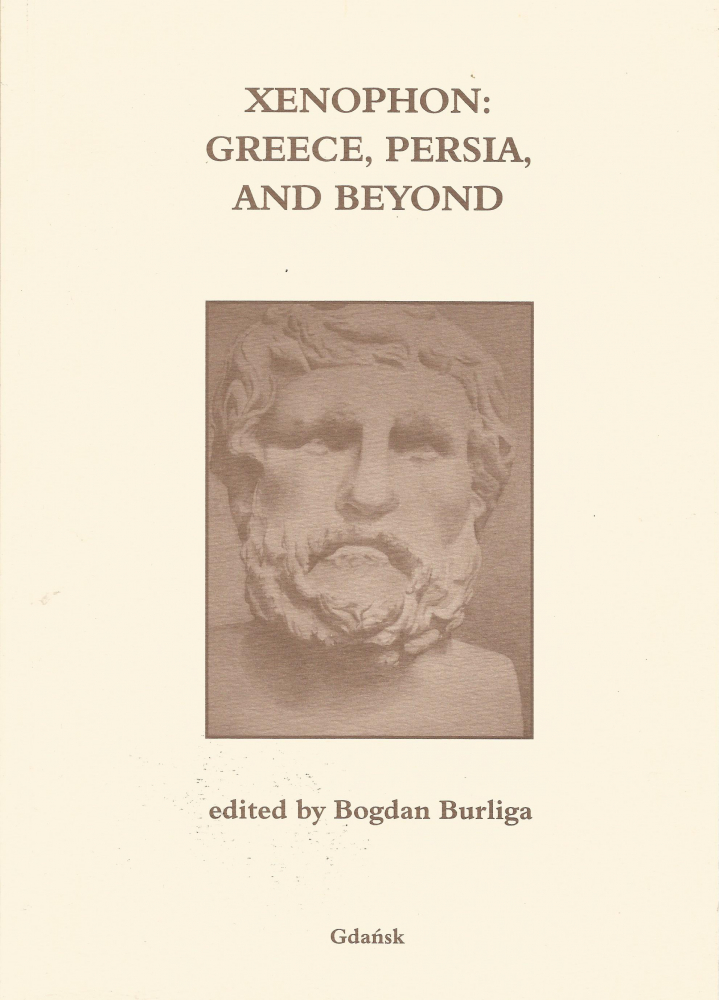
red. Bogdan Burliga, Xenophon: Greece, Persia, and Beyond, Seria Monografyczna ‘Akanthina’ Nr 5, Gdańsk, 2011, ISBN 978-83-7531-103-7, B5 (17 x 24 cm), str. 191, miękka okładka; 25 €/112.50 PLN.
Znaczenie prac Ksenofonta jako historycznych źródeł do dziejów starożytnej Grecji w okresie klasycznym jest bezsprzeczne. Wielu badaczy wykorzystuje prace tego pisarza jako bezcenne źródło informacji na temat imperium Achamenidów i jego relacji z Grekami. Biorąc pod uwagę ich niezwykłą różnorodność i wartość (większość z nich dało początek nowym gatunkom literackim), znaczenie Ksenofonta w historii literatury greckiej zaczęło być doceniane, jakkolwiek całkiem niedawno. W związku z tym rosnącym zainteresowaniem zwiększyła się też ilość książek i konferencji naukowych poświęconym Ksenofontowi.
Praca zawiera wybrane artykuły, wygłoszone na konferencji, która odbyła się w październiku 2009 roku w Uniwersytecie Gdańskim: w miejscu, w którym została napisana pierwsza monografia na temat Ksenofonta, autorstwa Krzysztofa Głombiowskiego. Spotkanie to zgromadziło polskich ekspertów od Ksenofonta i historii Grecji w IV wieku p.n.e., w tym wielu uczniów profesora Głombiowskiego. Poruszone tematy dotyczyły historii militarnej, literackich aspektów dzieł Ksenofonta oraz popularności Ksenofonta w programach gdańskich szkół w XVIII wieku.
Artykuły:
Krzysztof Ulanowski, The Rational and Magical-Religious Semiotics of War, Anabasis and the Military Campaigns of the Assyrian Kings in the 1st Millenium B.C.
Tytus Mikołajczak, Before Xenophon: Notes on Early Greek Accounts on the Core Inhabitants of the Persian Empire.
Sławomir Jędraszek, The Egyptian Phalanx in the Cyropaedia.
Nicholas V. Sekunda, Achaemenid and Lakedaimonian Infantry Organization in Xenophon’s Cyropaedia.
Tomasz Mojsik, The Muses and Sacrifices before Battle.
Jacek Rzepka, Xenophon and a Small Polis: Phleious in the Hellenica.
Małgorzata Mika, Xenophon as the First Theoretician of the Social Capital Concept
Anna Ryś, Xenophon’s Socrates and the Oracles.
Anna Marchewka, Socratic Laughter in the Xenophon’s Cyropaedia.
Bogdan Burliga, ἀεὶ μέντοι <τῷ> ἰσχυροτέρῳ τὸ ἀσθενέστερον θηρᾶν: The Meaning of the ‘Hunting’ Comparison in Xenophon’s Equit. mag. 4. 17.
Grzegorz Kotłowski, Ways and Means – the Last Work of Xenophon.
Bogdan Burliga, Did Xenophon Read Herodotus? The Tyrant’s Bloody End, Or the Herodotean Character of Xenophon’s Hell. 6. 4. 35 – 37.
Jacek Pokrzywnicki, Xenophon in the XVIIIth Century School Curriculum: Strategies of Teaching Greek in the Academic Gymnasium in Gdańsk.
Karol Polejowski, Edouard Delebecque’s Research on Xenophon.
ed. Bogdan Burliga, Xenophon: Greece, Persia, and Beyond, Monograph Series ‘Akanthina’ No. 5, Gdańsk, 2011, ISBN 978-83-7531-103-7, B5 (17 x 24 cm), pp. 191, paperback; 25 € /112.50 PLN.
The importance of Xenophon as a historical source for the history of Greece in the classical period has long been recognized as an established fact. Many scholars also rightly judge him to be a priceless source of information about the Achemenid Empire and the nature of its relations with the Greeks. Given the amazing variety, and the value, of his literary output (the majority of them constitute the very beginning of new literary genres), his importance in the history of Greek literature has also started to be appreciated, albeit quite recently. In consequence, the growing modern interest in Xenophon is manifested not only in books about him, but in the scholarly conferences too.
This book contains a selection of the papers delivered at a conference held in October 2009 at Gdańsk University: the place where the first monograph upon Xenophon in Polish was written by Professor Krzysztof Głombiowski. The meeting gathered Polish experts on Xenophon and history of Greece in the fourth century BC, including many of the disciples of Professor Głombiowski. The topics they chose for discussion included military history, the literary aspects of Xenophon’s production, and Xenophon’s popularity in Gdańsk school curricula in the eighteenth century).
The contributions are:
Krzysztof Ulanowski, The Rational and Magical-Religious Semiotics of War, Anabasis and the Military Campaigns of the Assyrian Kings in the 1st Millenium B.C.
Tytus Mikołajczak, Before Xenophon: Notes on Early Greek Accounts on the Core Inhabitants of the Persian Empire.
Sławomir Jędraszek, The Egyptian Phalanx in the Cyropaedia.
Nicholas V. Sekunda, Achaemenid and Lakedaimonian Infantry Organization in Xenophon’s Cyropaedia.
Tomasz Mojsik, The Muses and Sacrifices before Battle.
Jacek Rzepka, Xenophon and a Small Polis: Phleious in the Hellenica.
Małgorzata Mika, Xenophon as the First Theoretician of the Social Capital Concept
Anna Ryś, Xenophon’s Socrates and the Oracles.
Anna Marchewka, Socratic Laughter in the Xenophon’s Cyropaedia.
Bogdan Burliga, ἀεὶ μέντοι <τῷ> ἰσχυροτέρῳ τὸ ἀσθενέστερον θηρᾶν: The Meaning of the ‘Hunting’ Comparison in Xenophon’s Equit. mag. 4. 17.
Grzegorz Kotłowski, Ways and Means – the Last Work of Xenophon.
Bogdan Burliga, Did Xenophon Read Herodotus? The Tyrant’s Bloody End, Or the Herodotean Character of Xenophon’s Hell. 6. 4. 35 – 37.
Jacek Pokrzywnicki, Xenophon in the XVIIIth Century School Curriculum: Strategies of Teaching Greek in the Academic Gymnasium in Gdańsk.
Karol Polejowski, Edouard Delebecque’s Research on Xenophon.
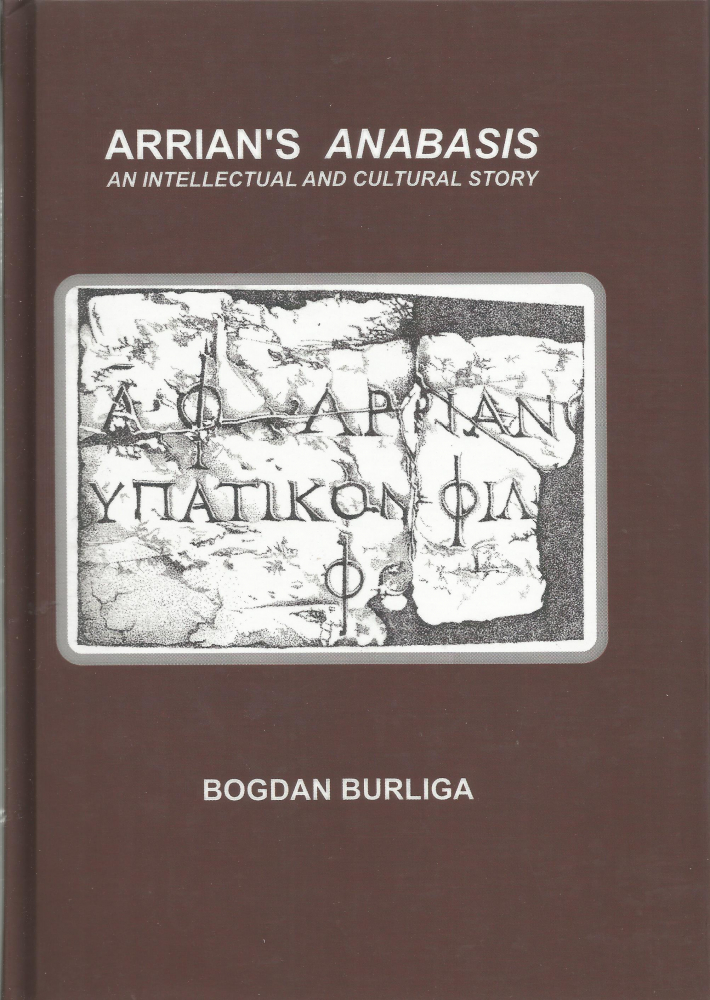
Bogdan Burliga, Arrian's Anabasis. An Intellectual and Cultural Story, Seria Monograficzna ‘Akanthina’ Nr 6, Gdańsk 2013, ISBN : 978-83-929798-0-7, B5 (17 x 24 cm), pp. vii + 167, bez ilustracji, twarda oprawa; 20,00 € / 90,00 PLN.
Książka ta to bardzo interesujące opracowanie na temat jednego z najważniejszych źródeł pochodzących ze starożytności. Nie jest to jednak kolejne studium historyczne na temat Aleksandra Wielkiego.
Arrian znany był przede wszystkim jako stoicki filozof, uczeń Epikteta. Tak był również postrzegany w starożytności, nie tylko przez swoich współczesnych, ale i przez kolejne pokolenia jego czytelników. Burliga wyciąga stąd logiczny wniosek, że Anabaza wykracza poza granice zwykłej narracji historycznej.
Anabaza, choć formalnie posiada formę narracji historycznej, jest również poważną (stoicką) refleksją nad posiadaniem i sprawowaniem władzy, a także kruchością lub niewielkim wpływem ludzkich wysiłków dla utrzymania prestiżu, sławy i chwały. Oznacza to nowe spojrzenie na kwestię, jak rozumieć Anabazę - dzieło, które w żadnym wypadku nie powinno być traktowane jako panegiryk dla Aleksandra i jego czynów.
W książce tej uwidacznia się znakomicie wiedza i szerokie oczytanie autora w literaturze naukowej, w tym tej starszej, ale wciąż wartej uwagi. Jest to studium, które wymaga od czytelnika wstępnej wiedzy na opisywany temat, jednocześnie jednak pozostaje ono wyjątkowo inspirującą pracą, rzucającą nowe światło na kwestie, które mogłyby wydawać się już w pełni wyczerpanymi.
Bogdan Burliga, Arrian's Anabasis. An Intellectual and Cultural Story, Monograph Series ‘Akanthina’ No. 6, Gdańsk 2013, ISBN : 978-83-929798-0-7, B5 (17 x 24 cm), pp. vii + 167, unillustrated, hardbound; 20,00 € / 90,00 PLN.
Dr. Bogdan Burliga has written is a very interesting study concerning one of the most important sources which has come down to us from Antiquity. The book is not, however, yet another historical study n Alexander the Great.
Arrian was first and foremost was known as a Stoic philosopher, a disciple of Epictetus, and was regarded as such in Antiquity, not only by his contemporaries, but by succeeding generations of his readership. Burliga draws the logical conclusion that the Anabasis goes beyond the bounds of a mere historical narrative.
The Anabasis, although formally a historical narrative, is a serious (Stoic) reflection upon the possession and exercise of power, and the fragility or insignificance of human efforts to retain prestige, fame and glory. This constitutes a new, refreshing view on the meaning of the Anabasis, a work which by no means should be taken as a panegyric to Alexander and his deeds.
The book displays the author’s masterly command of the secondary literature, including those of older vintage, yet still worth consulting. It is a work which requires some previous knowledge of the topic, but at the same time it remains exceptionally inspiring work, shedding new light on a topic which might seem already fully exploited.
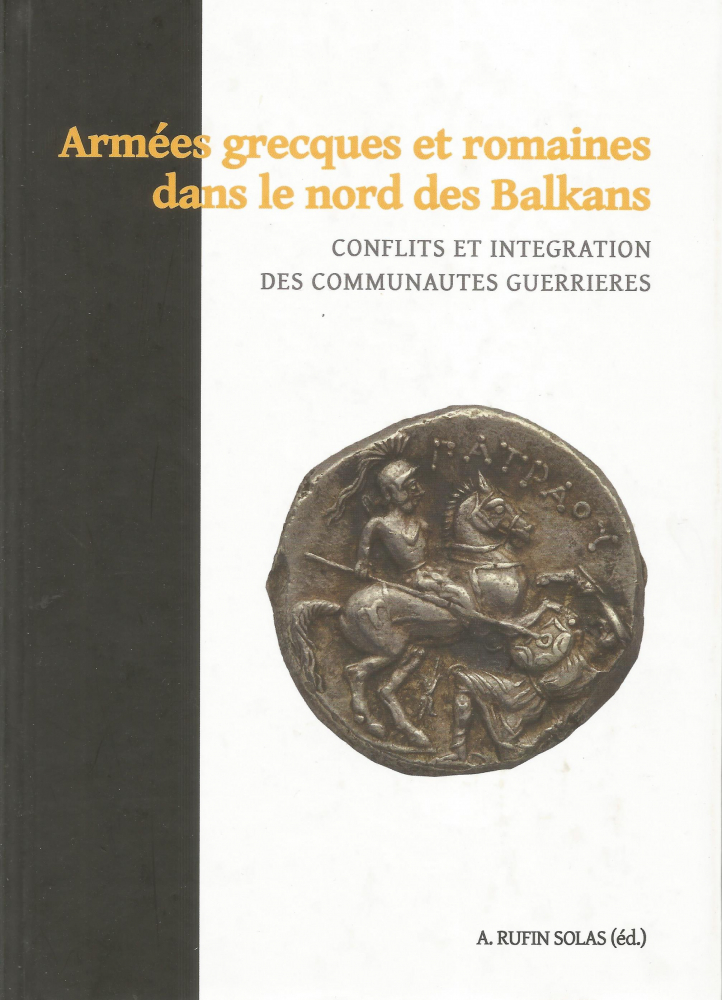
red. Aliénor Rufin Solas we współpracy z Marie-Gabrielle Parisaki and Elpidą Kosmidou, Armées grecques et romaines dans le nord des Balkans, Seria Monograficzna Akanthina No. 7, Gdańsk – Toruń 2013, ISBN: 978-83-936558-0-9, B5 (17 x 24 cm), str. 229, ilustrowana, twarda oprawa; 20,00 € / 90,00 PLN.
Niniejszy tom zawiera artykuły wygłoszone na dwóch konferencjach zatytułowanych "La Roumanie, Le livre, l'Europe", które miały miejsce w Rumunii, w ramach Bibliothèque Métropolitaine de Bucarest w latach 2010 i 2011 r., pod patronatem paryskiego projektu badawczego zatytułowanego "Structures guerrières et échanges entre peuples des Balkans’. Projest finansowany jest wspólnie przez Université Paris-Sorbonne IV i Center Lenain de Tillemont (UMR 8167 Orient et Méditerranée). Po wprowadzeniu napisanym przez redaktora, praca zawiera artykuły: Elpida Kosmidou, ‘Further thoughts on the coinage and politics of Alexander I’ pp. 15-27; Aliénor Rufin Solas, ‘L’or et l’argent des aristocraties thraces. Contribution de l’étude des trésors contenant des vases en métal précieux à l’histoire de la région aux IVe et IIIe siècles avant J.-C.’ pp. 29-50 (1 figure); Nicholas V. Sekunda, ‘The ‘Victory’ coinage of Patraos of Paionia’ pp. 53-67 (6 figures); Adrian Georges Dumitrou, ‘Les Séleucides et les Balkans: les Thraces dans les armées séleucides’ pp. 69-89; Peter Delev, ‘The burning of the temple at Delphi, the Roman governor L. Scipio and the rout of the Scordisci’ pp. 91-103; Maria-Gabriella Parissaki, ‘Thrace under Roman sway (146 BC – AD 46). Between warfare and diplomacy’ pp. 105-114; Albana Meta, ‘Guerre et circulation monétaire : le cas des drachmes de Dyrrachion’ pp. 117-131 (2 maps); Saimir Shpuza, ‘Illyriens et Romains. Du conflit à l’intégration’ pp. 133-143; Danijel Dzino, ‘The impact of Roman imperialism on the formation of group identities in some indigenous societies from the eastern Adriatic hinterland’ pp. 145-169 (2 maps); Katherine Low, ‘Tacitus and Thrace. Balkan auxiliaries from an historian’s perspective’ pp. 171-182; Ivo Topalilov, ‘The veterans and their descendents in the elite of Philippopolis, Thrace’ pp. 185-196 (3 tables); Oleg Alexandrov, ‘Ethnic and social composition of the Roman army in Moesia inferior: soldiers from Asia Minor and the eastern provinces of the Roman Empire’ pp. 199-207; Constantina Katsari, ‘Roman army and the monetisation of Dacia’ pp. 209-222. Na końcu książki umieszczono 6-stronnicowy indeks.
ed. Aliénor Rufin Solas in collaboration with Marie-Gabrielle Parisaki and Elpida Kosmidou, Armées grecques et romaines dans le nord des Balkans, Monograph Series Akanthina No. 7, Gdańsk – Toruń 2013, ISBN: 978-83-936558-0-9, B5 (17 x 24 cm), pp. 229, illustrations, hardbound; 20,00 € / 90,00 PLN.
This volume contains papers delivered at two conferences, entitled La Roumanie, Le livre, l’Europe, held in Rumania organized by the Bibliothèque Métropolitaine de Bucarest in 2010 and 2011, and held under the auspices of a Paris-based research project entitled ‘Structures guerrières et échanges entre peuples des Balkans’, jointly financed by the Université Paris-Sorbonne IV and the Centre Lenain de Tillemont (UMR 8167 Orient et Méditerranée). Following on from an introduction by the editor, the papers are as follows: Elpida Kosmidou, ‘Further thoughts on the coinage and politics of Alexander I’ pp. 15-27; Aliénor Rufin Solas, ‘L’or et l’argent des aristocraties thraces. Contribution de l’étude des trésors contenant des vases en métal précieux à l’histoire de la région aux IVe et IIIe siècles avant J.-C.’ pp. 29-50 (1 figure); Nicholas V. Sekunda, ‘The ‘Victory’ coinage of Patraos of Paionia’ pp. 53-67 (6 figures); Adrian Georges Dumitrou, ‘Les Séleucides et les Balkans: les Thraces dans les armées séleucides’ pp. 69-89; Peter Delev, ‘The burning of the temple at Delphi, the Roman governor L. Scipio and the rout of the Scordisci’ pp. 91-103; Maria-Gabriella Parissaki, ‘Thrace under Roman sway (146 BC – AD 46). Between warfare and diplomacy’ pp. 105-114; Albana Meta, ‘Guerre et circulation monétaire : le cas des drachmes de Dyrrachion’ pp. 117-131 (2 maps); Saimir Shpuza, ‘Illyriens et Romains. Du conflit à l’intégration’ pp. 133-143; Danijel Dzino, ‘The impact of Roman imperialism on the formation of group identities in some indigenous societies from the eastern Adriatic hinterland’ pp. 145-169 (2 maps); Katherine Low, ‘Tacitus and Thrace. Balkan auxiliaries from an historian’s perspective’ pp. 171-182; Ivo Topalilov, ‘The veterans and their descendents in the elite of
Philippopolis, Thrace’ pp. 185-196 (3 tables); Oleg Alexandrov, ‘Ethnic and social composition of the Roman army in Moesia inferior: soldiers from Asia Minor and the eastern provinces of the Roman Empire’ pp. 199-207; Constantina Katsari, ‘Roman army and the monetisation of Dacia’ pp. 209-222 followed by a 6-page index.

Nicholas Victor Sekunda, The Antigonid Army, Seria Monografyczna Nr 8, Gdańsk 2013, ISBN 978-83-7531-266-9, B5 (17 x 24 cm); str. 131, fig. 55 figures, tabl. 2, twarda okładka; 20,00 € / 90,00 PLN.
Praca dotyczy różnych aspektów macedońskiej armii za panowania dynastii Antygonidów. Dynastia ta rządziła Macedonią pomiędzy 294 i 168 rokiem p.n.e. Dowody przedstawione są głównie w dwóch pierwszych rozdziałach książki. Pierwszy rozdział dotyczy grobowca Lysona i Kalliklesa, w drugim autor bada kwestie przetrwania antygonidzkiej sztuki w rzymskich kopiach. Reszta książki dotyczy literackiego i epigraficznego materiału, który odnosi się do armii Antygonidów. Rozdział 3. dotyczy dowództwa i sztabu armii, rozdział 4. – kawalerii, a rozdziały 5 i 6 zajmują się wyposażeniem i organizacją piechoty. Rozdział 7 dotyczy mobilizacji armii, a więc również sposobu, w jaki było zorganizowane królestwo Macedonii. W ostatnim, 8. rozdziale przedstawiono dowody na istnienie leukaspides w armi Antygonidów. Leukaspides są tylko dwukrotnie wymienieni w kontekście Antygonidów, podczas bitw pod Selazją i Pydną. Autor dochodzi do kontrowersyjnych wniosków, że wzmianki te dotyczą tak naprawdę sprzymierzonych sił thyreophoroi. W rozdziale tym autor podejmuje się również próby nowej rekonstrukcji bitwy pod Pydną. Książka nie dotyczy ani artylerii, ani marynarki wojennej.
Nicholas Victor Sekunda, The Antigonid Army, Monograph Series Akanthina No. 8, Gdańsk 2013, ISBN 978-83-7531-266-9, B5 (17 x 24 cm); pp. 131, figs. 55, tab. 2, hardbound; 20,00 € / 90,00 PLN.
This book deals with the Macedonian army under the Antigonid dynasty, who ruled Macedon from 294 BC until 168 BC. The representational evidence is mainly dealt with in the first two chapters. Chapter 1 deals with the Tomb of Lyson and Kallikles, and Chapter 2 with the survival of some Antigonid Court art in Roman copies. The rest of the book deals with the literary and epigraphic material relating to the army. Chapter 3 deals with Army Command and Staff, Chapter 4 with the Cavalry, Chapter 5 with Infantry Equipment and Chapter 6 with Infantry Organization. Chapter 7 deals with the Mobilization of the army, and so, necessarily with the way the kingdom of Macedonia was organized. The final Chapter 8 is concerned with the evidence for the leukaspides phalanx in the Antigonid army. The leukaspides are only mentioned twice in an Antigonid context, at the battles of Sellasia and Pydna, and the author reaches the controversial conclusion is that the references refer to allied forces of thureophoroi during the two battles. In the course of this chapter the author attempts a new reconstruction of the battle of Pydna. The book neither deals with artillery nor naval matters.

red. Nicholas Victor Sekunda, Bogdan Burliga, Iphicrates, Peltasts and Lechaion, Akanthina nr 9, Gdańsk 2014, ISBN 978-83-7531-167-9, B5 (17 x 24 cm); twarda oprawa, str. 144; 20,00 € / 90,00 PLN.
Prace zebrane w tym tomie są uzupełnieniem artykułu o bitwie pod Lechajonem, autorstwa Andreasa Konecnego. Artykuł ten został pierwotnie opublikowany w periodyku Chiron 31 (2001) i w prezentowanym tomie został przetłumaczony na angielski przez Briana Bertosę. Konecny nie tylko dokonuje w nim próby odtworzenia lokalizacji oraz poszczególnych faz bitwy, ale także, zgodnie z nowoczesnymi kanonami współczesnych studiów wojennych próbuje zgłębić sposób myślenia walczących.
Dwa kolejne rozdziały dotyczą sił lacedemońskich, zaangażowanych w bitwę. Pierwszy, autorstwa Nicholasa Sekundy, analizuje skład mory, która poniosła klęskę. Drugi, autorstwa Bogdana Burligi dotyczy postepowania żołnierzy mory. Następny rozdział, autorstwa Roela Konijnendijka, dotyczy późniejszej historiografii na temat bitwy, oraz sposobu, w jaki rodziła się sława Ifikratesa jako innowatora wojskowego.
Następne trzy rozdziały książki dotyczą peltastów i ich ewolucji. Sławomir Sprawski bada dowody na istnienie peltastów w tesalskich siłach zbrojnych od pierwszej połowy V wieku p.n.e. Z kolei Brian Bertosa analizuje, między innymi, dowody na używanie przez peltastów broni w bezpośrednim starciu przed ‘reformą’ Ifikratesa. W ostatnim rozdziale Nicholas Sekunda bada dowody na początki reformy peltastów, jakiej dokonał Ifikrates w trakcie przygotowań do drugiej inwazji perskiej na Egipt w 377/6-373 roku p.n.e.
eds. Nicholas Victor Sekunda, Bogdan Burliga, Iphicrates, Peltasts and Lechaion, Akanthina no. 9, Gdańsk 2014, ISBN 978-83-7531-167-9, B5 (17 x 24 cm); hardbound, pp. 144; 20,00 € / 90,00 PLN.
The works assembled in this volume complement the article written on the battle of Lechaeum by Andreas Konecny in Chiron 31 (2001), which is here translated into English by Brian Bertosa. Konecny not only reconstructs the location and phases of the battle, in the best traditions of traditional military history, but attempts, according to the newly established canons of modern war studies, to get into the minds of the soldiers involved.
The two following chapters deal with the Lacedaemonian forces involved in the battle, the first, by Nicholas Sekunda, analyzes the components of the mora that suffered defeat. The second, by Bogdan Burliga, deals with their conduct. There follows a contribution by Roel Konijnendijk on the histo¬riography of the battle in later times, and the building of the reputation of Iphicrates as a military innovator.
The following three chapters of the book deal with peltasts and their evolution. Siawomir Sprawski studies the evidence for peltasts incorporated in Thessalian armed forces from the first half of the fifth century onwards. In the following chapter Brian Bertosa considers, among other matters, the evidence for peltasts carrying close-quarter weaponry prior to the fabled 'Iphicratean reform'. In the last chapter, Nicholas Sekunda argues that the Iphicratean Peltast Reform took place during preparations for the second Persian invasion of Egypt 377/6 - 373 BC.
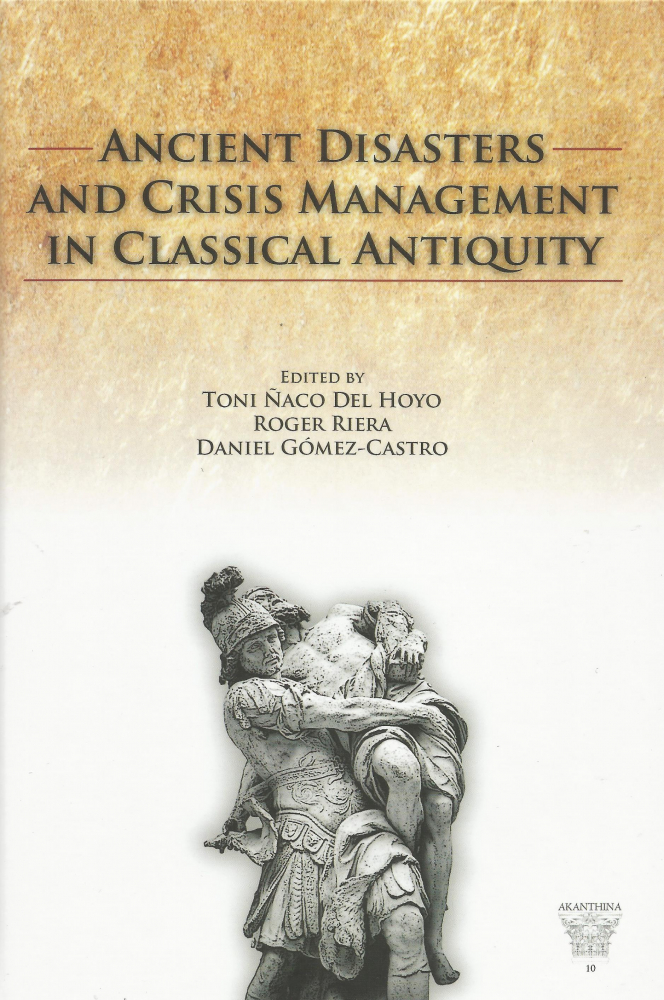
red. Toni Naco del Hoyo, Roger Riera, Daniel Gómez-Castro, Ancient Disasters and Crisis Management in Classical Antiquity, Akanthina 10, Gdańsk, 2015, ISBN 978-83-7531-217-1, B5 (17 x 24 cm); twarda oprawa; 20,00 € / 90,00 PLN.
Przez całe tysiąclecia katastrofy, czy to naturalne, czy wywołane działaniami człowieka, miały wielki wpływ na społeczeństwa. W świecie grecko-rzymskim, podobnie jak teraz, bezpośrednie konsekwencje takich katastrof wyprzedzały następujące po nich kroki, które podejmowały władze publiczne lub ktokolwiek, kto był do tego uprawniony. Niniejszy tom powstał w ramach warsztatów naukowych, finansowanych z hiszpańskiego grantu badawczego. Dwa teoretyczne rozdziały tej pracy dotyczą rzeczywistego znaczenia katastrof dla antycznych, jak również tego, jak współczesna terminologia - taka jak ‘kryzys humanitarny’ - zniekształca nasze postrzeganie wydarzeń ze odleglej przeszłości. Kolejne rozdziały poruszają tematy ubocznych szkód w trakcie wojny; sposobów, jak społeczności radziły sobie po trzęsieniach ziemi; zerwanych stosunków międzypaństwowych; deportacji czy działań wobec pokonanych społeczności.
eds. Toni Naco del Hoyo, Roger Riera, Daniel Gómez-Castro, Ancient Disasters and Crisis Management in Classical Antiquity, Akanthina 10, Gdańsk, 2015, ISBN 978-83-7531-217-1, B5 (17 x 24 cm); hardback; 20,00 € / 90,00 PLN.
Ancient Disasters and Crisis Management in Classical Antiquity
Edited by Toni Naco del Hoyo, Roger Riera, and Daniel Gómez-Castro,
For millennia catastrophes, whether those caused by nature, or by human violence, have impacted on historical societies. In the Graeco-Roman world, as nowadays, the immediate consequences of such disasters only anticipated subsequent measures applied by the public authorities, or whoever was in charge thereafter. This volume originated in a workshop funded by a Spanish research grant. Two theoretical chapters deal with the actual meaning of catastrophes for the ancients, as well as how distorted our view of the remote past may be when applying modern terminology such as ‘humanitarian crises’ to events in the ancient world. The following chapters seek to explore such topics as collateral damage in war, earthquake recovery, breakdown of interstate relations, deportation, and postwar policies implemented on defeated societies.
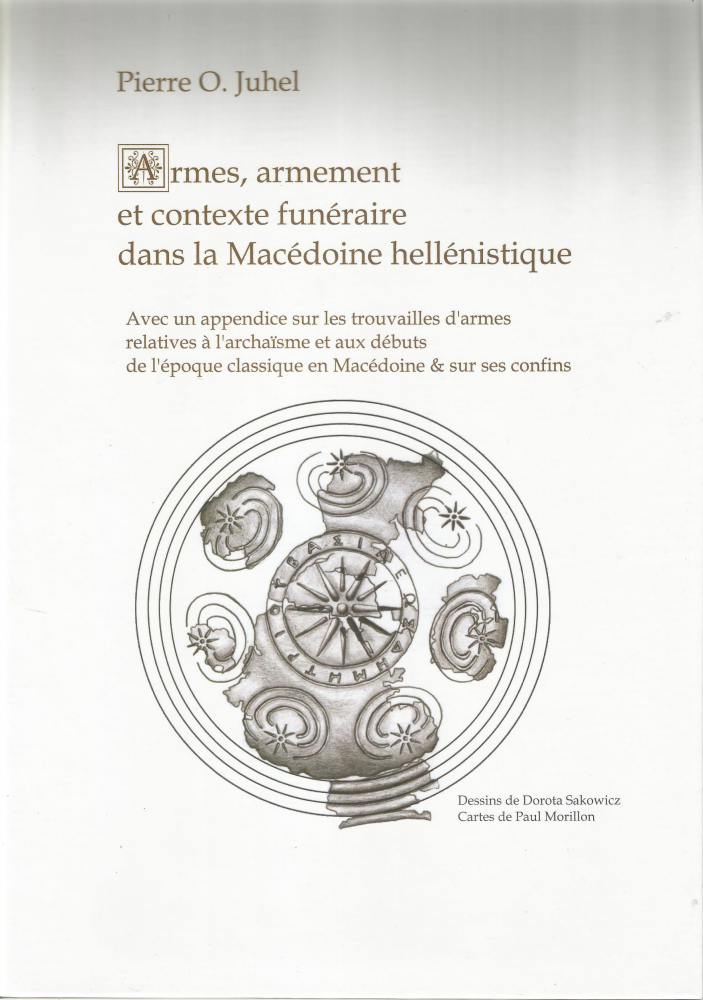
Pierre O. Juhel ; rysunki: Dorota Sakowicz ; mapy: Paul Morillon, Armes, armement et contexte funéraire dans la Macédoine hellénistique. Avec un appendice sur les trouvailles d’armes relatives aux époques archaïque et classique en Macédoine & sur ses confins, Akanthina no. 11, Gdańsk 2017, ISBN: 978-83-7531-182-2, A4 (21 x 29,7 cm), str. 105 ilustrowana (niektóre w kolorze), oprawa twarda; 20,00 € / 90,00 PLN.
Publikacja, napisana w języku francuskim, jest kompletnym katalogiem (w formie tabelek) broni z okresu hellenistycznego znalezionej w grobach na terenie starożytnej Macedonii. Rzuca ona nowe światło na uzbrojenie starożytnych Macedończyków oraz historię ich kraju. Juhel w osobnym, trzy-częściowym załączniku, powołuje się również na znaleziska broni z okresu archaicznego i klasycznego. Pierwsza część to materiał wymieniany w Arkheologikon Deltion (59-68), druga to materiał z innych źródeł (69-75). W trzeciej części Juhel dowodzi, że państwo przejęło zadanie dostarczania uzbrojenia i omawia rolę Aleksandra I ‘Filhellena’ w stworzeniu macedońskiej armii. Praca ta stanowi wartościową pomoc badawczą dla każdej osoby, która pragnie podjąć tematykę macedońskiej armii, jak również innych aspektów związanych ze starożytną Macedonią. Katalog jest bogato ilustrowany 37 ilustracjami, częściowo barwnymi (ss.84-93) i dwiema kolorowymi mapami wewnątrz okładek.
Pierre O. Juhel. dessins de Dorota Sakowicz, cartes de Paul Morillon, Armes, armement et contexte funéraire dans la Macédoine hellénistique. Avec un appendice sur les trouvailles d’armes relatives aux époques archaïque et classique en Macédoine & sur ses confins, Akanthina no. 11, Gdańsk 2017, ISBN: 978-83-7531-182-2, A4 (21 x 29,7 cm), p. 105 illustrated (some in colour), hardbound; 20,00 € / 90,00 PLN.
This work (in French) constitutes an exhaustive catalogue raisonné of weapons, in tabular form, found in funerary contexts throughout the territory of Ancient Macedonia in the Hellenistic period. The results shed a new light not only on the weaponry of the ancient Macedonians but more broadly on the history of Ancient Macedon. Juhel contrasts the situation in the Archaic and Classical periods, where arms are more plentiful in an extensive appendix, divided into three parts. The first gathers material listed in Arkheologikon Deltion (59-68), the second ( 69-75) material assembled from other sources. In the third the concludes that the state took over the role of supplying weapons, and discusses the role of Alexander I Philhellenos as a founder of the Macedonian army. This work is invaluable research tool to anybody pursuing research into the Macedonian army, or, indeed, into any aspect of ancient Macedonia. The catalogue is richly illustrated (pp. 84-93) with 37 figures, some in colour, and two colour maps inside the covers.
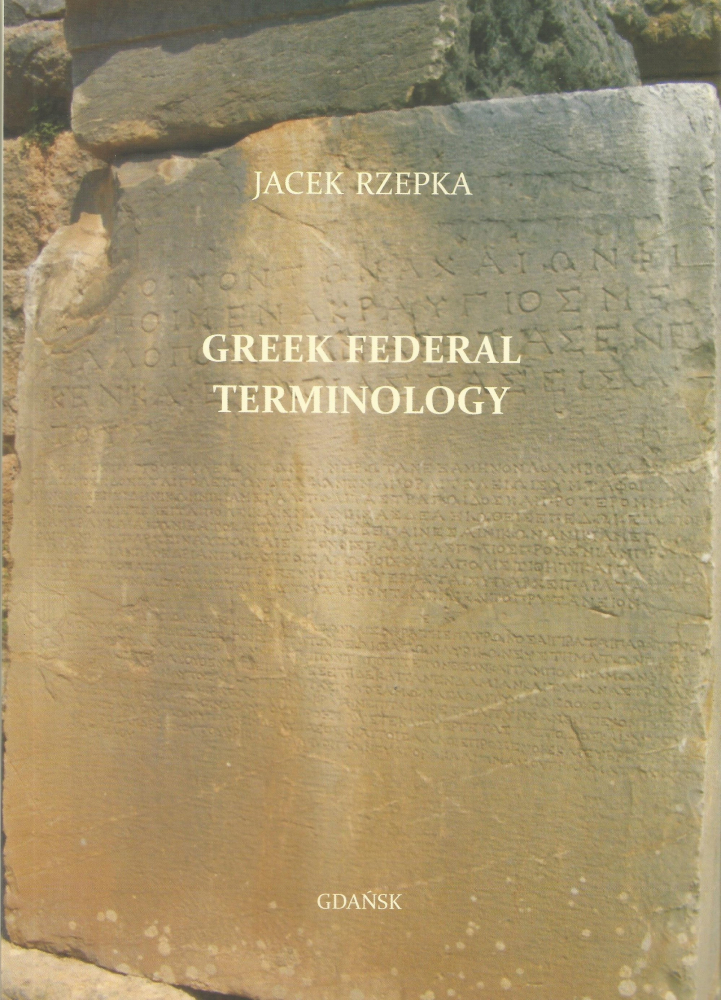
Jacek Rzepka, Greek Federal Terminology, Akanthina no. 12, Gdańsk 2016, ISBN 978-83-7531-237-9, B5 (17 x 24 cm); 110 p., miękka okładka; 15,00 € / 67,50 PLN.
Greek Federal Terminology jest studium słownictwa, które starożytni Grecy używali do opisywania stanów państwowych innych niż państwa-miasta. Niektóre z takich jednostek państwowych, jak Beocja w IV wieku p.n.e. czy Achaja i Etolia w III wieku p.n.e. osiągnęły status supermocarstw w Greckiej polityce. Jednostki te są obecnie nazywane federacjami, choć istnienie koncepcji myśli federalistycznej w greckiej myśli politycznej jest podważane. W poszukiwaniu języka federalistycznego Rzepka analizuje szereg inskrypcji, świadczących o specyfice greckich lig i życiu Greków w federacjach. Powołuje się on również na szeroki zakres klasycznych autorów. Optuje on za tym, że świadomy wybór technicznych terminów stosowanych przez wieki w greckich ligach, a zwłaszcza pojawienie się federalistycznego żargonu w okresie hellenistycznym są oczywistymi cechami federalistycznej ścieżki myśli politycznej. Wymienia on również kamienie milowe w rozwoju języka federalistycznego wśród starożytnych Greków.
Jacek Rzepka, Greek Federal Terminology, Akanthina no. 12, Gdańsk 2016, ISBN 978-83-7531-237-9, B5 (17 x 24 cm); 110 p., miękka okładka; 15,00 € / 67,50 PLN.
Greek Federal Terminology to studium słownictwa, jakim posługiwali się starożytni Grecy przy opisie organizmów państwowych innych niż polis (miasto-państwo). Niektóre z takich organizmów, jak Beocja w IV wieku p.n.e. czy Achaja i Etolia w III wieku p.n.e., osiągnęły status supermocarstw w greckim życiu politycznym. Państwa te są obecnie zwykle określane jako federacje, choć istnienie koncepcji myśli federalistycznej w greckiej teorii politycznej jest podważane. W poszukiwaniu języka federalistycznego Rzepka analizuje szereg inskrypcji, świadczących o specyfice greckich lig i życiu Greków w strukturach federacji. Powołuje się on również na szeroki zakres klasycznych autorów. Autor optuje za tezą, że świadomy wybór technicznych terminów, jakie stosowano przez wieki w greckich ligach, a zwłaszcza pojawienie się federalistycznego żargonu w okresie hellenistycznym, są oczywistymi cechami federalistycznej myśli politycznej. Można także wykazać przełomowe punkty w rozwoju języka federalistycznego starożytnych Greków.
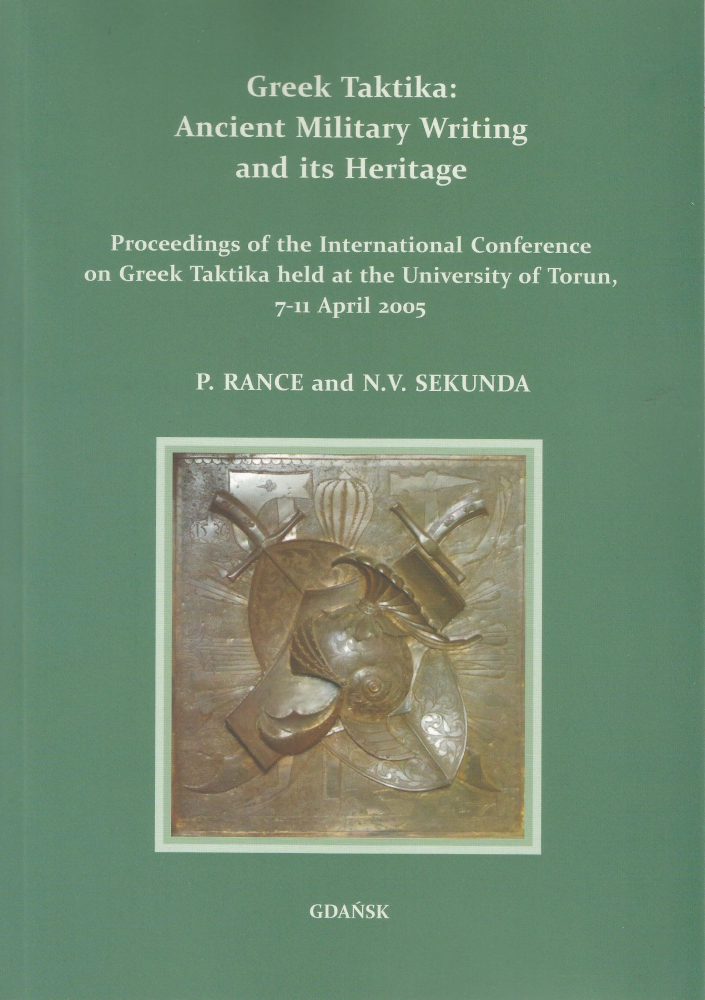
red. Philip Rance & Nicholas Victor Sekunda
Greek Taktika: Ancient Military Writing and its Heritage
Proceedings of the International Conference on Greek Taktika held at the University of Toruń, 7-11 April 2005, Akanthina no. 13, Gdańsk, 2017, ISBN 978-83-7531-242-3, B5 (17 x 24 cm); str.300, ilustrowana, miękka okładka; 20,00 € / 90,00 PLN.
Poza doskonale udokumentowanym wstępem Philipa Rance, który ukazuje
historyczny rozwój piśmiennictwa wojskowego w starożytności i zmiany we współczesnej nauce w tej dziedzinie, książka zawiera 15 artykułów. Wygłoszono je na konferencji o ' Greckich taktika’ ('Greek taktika'). Większość z nich to szczegółowe rozprawy na temat taktyki (sztuki formowania armii) w starożytności i stosowania tej sztuki w praktyce, jak
również na tematy pokrewne, mieszczące się w szerszej problematyce starożytnego piśmiennictwa wojskowego. Ostatnie dwa artykuły zajmują się recepcją taktyki starożytnej w okresie wczesno-nowożytnym i jej wpływem na wojskowość w Europie Zachodniej i Wschodniej.
Spis treści;
Burkhard Meißner, Early Greek Strategic and Tactical Teaching and Literature.
Hans Michael Schellenberg, Reflections on the Military Views of the ‘Military Writer’ Aeneas Tacticus.
Bogdan Burliga, Tactical Issues in Aeneas ‘Tacticus’.
Alexander Nefedkin, The Classification of Greco-Macedonian Cavalry in Ancient Taktika
and in Modern Literature.
Niicholas Sekunda, Cavalry Organisation in the Taktika: the Tarantinarchia.
Bogdan Burliga, Asclepiodotus’ τοῖς γε σώμασιν ἐπιβρίθοντες (Tactica 5.2) and Polybius’ τῷ τοῦ σώματος βάρει (18.30.1-4).
Hans Michael Schellenberg, Short Bibliographical Note on the Arabic Translation
of Aelian’s Tactica Theoria.
Jacek Rzepka, Polyaenus and the Creation of Hellenistic Monarchy.
Sławomir Sprawski, Alexander at Tempe: Polyaenus, Strategemata 4.3.23.
Pierre O. Juhel, The Rank Insignia of the Officers of the Macedonian Phalanx: the Lessons of Iconography and an Indirect Reference in Vegetius.
Radosław A. Gawroński, The Javelins used by the Roman Cavalry of the Early Principate
in Archaeological Contexts and Written Sources.
Wojciech Brillowski, The Principles of ars tactica: Roman Military Theory and Practice
in Arrian’s Acies contra Alanos.
Philip Ranc, Maurice’s Strategicon and ‘the Ancients’: the Late Antique Reception
of Aelian and Arrian.
Keith Roberts, The Practical Use of Classical Texts for Modern War in the Sixteenth
and Seventeenth Centuries.
Richard Brzezinski, The Influence of Classical Military Texts in Early Modern Poland: a Survey.
Eds. Philip Rance & Nicholas Victor Sekunda
Greek Taktika: Ancient Military Writing and its Heritage
Proceedings of the International Conference on Greek Taktika held at the University of Toruń, 7-11 April 2005, Akanthina no. 13, 2017, Gdańsk, ISBN 978-83-7531-242-3, B5 (17 x 24 cm); 300 p. b/w illus, Pb; 20,00 € / 90,00 PLN.
Following a well-documented introduction by Philip Rance, giving the historical development of the military writing in Antiquity, and the evolution of modern scholarship on the subject, this book presents 15 papers given at a conference on the Greek Taktika. The majority of the papers are detailed treatments of the Taktika (the art of drawing up an army) and their application in the field in Antiquity, or related topics within the wider sphere on ancient military writing. The last two papers study the military influence of the Taktika in the early modern period on warfare in Western and Eastern Europe.
List of Contents:
Burkhard Meißner, Early Greek Strategic and Tactical Teaching and Literature.
Hans Michael Schellenberg, Reflections on the Military Views of the ‘Military Writer’ Aeneas Tacticus.
Bogdan Burliga, Tactical Issues in Aeneas ‘Tacticus’.
Alexander Nefedkin, The Classification of Greco-Macedonian Cavalry in Ancient Taktika
and in Modern Literature.
Niicholas Sekunda, Cavalry Organisation in the Taktika: the Tarantinarchia.
Bogdan Burliga, Asclepiodotus’ τοῖς γε σώμασιν ἐπιβρίθοντες (Tactica 5.2) and Polybius’ τῷ τοῦ σώματος βάρει (18.30.1-4).
Hans Michael Schellenberg, Short Bibliographical Note on the Arabic Translation
of Aelian’s Tactica Theoria.
Jacek Rzepka, Polyaenus and the Creation of Hellenistic Monarchy.
Sławomir Sprawski, Alexander at Tempe: Polyaenus, Strategemata 4.3.23.
Pierre O. Juhel, The Rank Insignia of the Officers of the Macedonian Phalanx: the Lessons of Iconography and an Indirect Reference in Vegetius.
Radosław A. Gawroński, The Javelins used by the Roman Cavalry of the Early Principate
in Archaeological Contexts and Written Sources.
Wojciech Brillowski, The Principles of ars tactica: Roman Military Theory and Practice
in Arrian’s Acies contra Alanos.
Philip Ranc, Maurice’s Strategicon and ‘the Ancients’: the Late Antique Reception
of Aelian and Arrian.
Keith Roberts, The Practical Use of Classical Texts for Modern War in the Sixteenth
and Seventeenth Centuries.
Richard Brzezinski, The Influence of Classical Military Texts in Early Modern Poland: a Survey.




